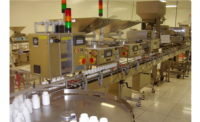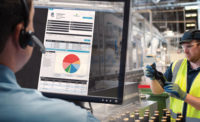Machinery Technology: Cartoning
Lean, clean cartoning machines
New advancements lead to cartoners with smaller footprints and improved capabilities



Cama Group utilizes Festo AG’s technology to minimize the CL 175’s footprint.



New technology may allow machines to pack more and more cartons per minute, but machinery companies are working to provide additional improvements that will help with the overall function of the machine and the line where it is placed. For example, machines with a smaller footprint fit better into the packaging line and make room for new machines and technology. Those that offer the flexibility to run various sizes make packaging lines more versatile. Quick changeover keeps lines from losing the momentum gained from speedy machines. Each innovation has the opportunity to impact flow of the entire packaging line.
The clean one
Langen Group (langengroup.com) has released a new cartoner specifically to improve the ease of providing hygienic conditions. The new Vento is designed to live up to expectations of speed and reliability while also meeting rigid hygiene requirements. Where the new Vento seeks to stand apart is by working to reach higher levels of efficiency while maintaining those hygiene standards.
Langen created the new Vento using input from companies and industry organizations covering the food, healthcare and consumer goods markets. The company expects that hygienic performance will be important for both primary and secondary packaging in the future. By offering the new Vento, Langen plans to serve that market with a machine that will provide the combination of speed and footprint with its hygiene features. The Vento can handle a throughput of 500 cartons per minute thanks to its five-head rotary feeder for maximum speed, a variety of infeed systems, automatic carton loader, a tuck-in flap closer and confiner.
The Vento’s primary difference is in the design. Langen has created the machine with hygiene as a primary function by building it with reduced flat services, fewer hollow bodies and easy cleaning features. The touch screen control panel makes it easy to operate. The Vento also offers an extended carton magazine with quick change features, easy access for faster cleaning, and a design that helps prevent build-up of water, dust and bacteria.
The changeable one
Because packaging lines need machines that can adapt to change, Triangle Packaging Machinery (trianglepackage.com) offers the Flex 1 Cartoner. This horizontal cartoner loads single- or twin-pack packages and can handle up to 100 cartons per minute. The Flex1 space seeks to reduce production costs by offering several benefits over traditional horizontal cartoners.
The Flex 1 can run a variety of carton sizes. To make this an easy transition on busy packaging lines, the machine’s tool-less changeover takes less than 20 minutes. By eliminating the barrel-loader assembly, the Flex 1 is less complex and, therefore, easier to maintain. This also means there will be reduced product breakage. The Flex 1 also has intermittent motion control and eliminates the need to synchronize bagger and cartoner. All of these features pack into a compact footprint of 10-feet by five and half feet.
The Flex 1 integrates seamlessly with the Triangle X-Series VFFS Bagger and direct-mounted Triangle InLine Weigher. It is designed for bag-in-box applications such as cereals, powders, grains and bakery products. The Flex 1 is also suitable for individually quick frozen products or trays. Triangle will be demonstrating the Flex 1 as part of a complete bag-in-box system at PACK EXPO International in November in Chicago.
The compact one
Cama Group (camagroup.com) has developed a completely new machine generation they are calling the “Cama Breakthrough Generation.” These machines are restyled to reduce the footprint. Where traditional machines feature large control cabinets that sit outside the main structure of the machine, the Breakthrough Generation machines integrate the control cabinets into the machine pedestals. This not only saves space, but it also minimizes cabling making it easier to place utility devices where they are needed. All of these advancements are made possible by Festo AG’s (festo.com/packaging) valve terminal concept CPX/MPA. CPX links the pneumatic and electrical control chains seamlessly to any automation concept. This can work with any company-specific standards.
“Significantly fewer and shorter cables and tubes to be connected simplify and shorten installation. This is a further distinguishing feature of the new machines,” says Stefano Rini, head of research and development with Cama Group. “What is more, the CPX offers diagnostic functions. This makes it easy for us to meet the demands of large branded-product manufacturers, for example, for preventive maintenance.”
As part of the Breakthrough Machine Generation, Cama is introducing the CL 175, a flexible side-loading carton machine. The redesigned machine can load flow-wraps, pouches, bags, thermoformed trays, blisters and more into pre-glued cartons. The side-loading unit loads product into cartons with intermittent-continuous motion. A Festo electric axis EGC makes up this handling unit providing precision to intermediate position and pneumatic mini slide DGSL. The EGC reduces the mounting time by 30% compared to the previous self-made axis. High precision and high load capacity can be achieved because of the combination of pneumatic and electrical drive technologies.
“[Festo’s] innovative valve terminals with CPX and fieldbus considerably reduce the amount of wiring and tubing required and thus also reduce the space required by our machines. Festo’s innovations, therefore, enable us as an OEM and our end customers to take a large step forward,” says Rini.
No matter how small or large the innovation, packaging machinery companies are working to make sure cartoning machines serve the customers and allow those customers to make the most of their packaging lines. Smaller, faster, cleaner machines with greater flexibility give companies the tools they need to focus on their own innovations.
Looking for a reprint of this article?
From high-res PDFs to custom plaques, order your copy today!












